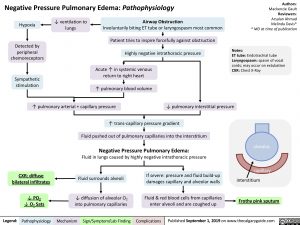Negative Pressure Pulmonary Edema: Pathophysiology
Authors: Mackenzie Gault Reviewers: Arsalan Ahmad Melinda Davis* * MD at time of publication
Notes:
ET tube: Endotrachial tube Laryngospasm: spasm of vocal cords; may occur on extubation CXR: Chest X-Ray
Hypoxia
Detected by peripheral chemoreceptors
Sympathetic stimulation
↓ ventilation to lungs
Airway Obstruction
Involuntarily biting ET tube or laryngospasm most common
Patient tries to inspire forcefully against obstruction
Highly negative intrathoracic pressure
Acute ↑ in systemic venous return to right heart
↑ pulmonary blood volume ↑ pulmonary arterial + capillary pressure
↓ pulmonary interstitial pressure ↑ trans-capillary pressure gradient
Fluid pushed out of pulmonary capillaries into the interstitium
Negative Pressure Pulmonary Edema:
Fluid in lungs caused by highly negative intrathoracic pressure
alveolus capillary
interstitium
Frothy pink sputum
CXR: diffuse bilateral infiltrates
↓ PO2 ↓ O2 Sats
Fluid surrounds alveoli
↓ diffusion of alveolar O2 into pulmonary capillaries
If severe: pressure and fluid build-up damages capillary and alveolar walls
Fluid & red blood cells from capillaries enter alveoli and are coughed up
Legend:
Pathophysiology
Mechanism
Sign/Symptom/Lab Finding
Complications
Published September 1, 2019 on www.thecalgaryguide.com
Foundations
Systems
Other Languages
Anesthesia Complications of Anesthetic Drugs Negative Pressure Pulmonary Edema: Pathophysiology Negative-Pressure-Pulmonary-Edema

